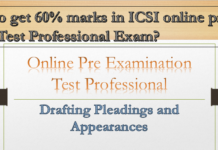Here are the some multi-choice questions enlisted for preparation for Pre Examination online Test, E-Learning ICSI & LAWs Law Examination. These Multi-choice questions or MCQs can help you in your CS & CA and other law related exams. We have also provided Online exam solved answers for your preparation.
Note: Answers highlighted in Green are right answers.
- No employer has a right to restrain an employee from taking up competing employment after the term of employment.
- Answer : Section 27 of the Indian Contract Act, 1872
Reason:
- What is a non-compete clause?
A non-compete clause under the Contractual Laws is the clause in an employment agreement whereby the employee undertakes and gives his acceptance to the condition of the employer that during the employment or even after the employee leaves the services of the employer, he will not be the competitor of the employer in the form and nature of the employment of the employer.
- From an Indian legal perspective, the Non-compete clause is prohibited under the Law of Contracts. Section 27 of the Indian Contract Act-1872 provides that – Every agreement by which anyone is restrained from exercising a lawful profession or trade or business of any kind, is to that extent void. Indian courts have also consistently refused to enforce post-termination non-compete clauses in employment contracts as restraint of trade is impermissible under section 27 of the Indian Contract Act-1872, and have held them as void and against the public policy because of their potential to deprive an individual of his or her fundamental right to earn a living.
For any restrictive covenant to fall within the ambit of Section 27 of the Contract Act, the agreement has to be in restraint of trade. Unlike the law in the United Kingdom, the Contract Act does not distinguish between partial and total restraint of trade, if the clause amounts to restraint post-termination of the agreement, then the same is void. Section 27 does not offer insight as to what kinds of restraints are valid; the qualification of reasonable restraints being valid and enforceable has been read into Section 27 by the courts.
- _______________is a process by which startegies and policies are put into action through the development of programs, budgets and procedures
- Correct Answer : Strategy implementation
Reason: Strategy implementation– The process by which strategies and policies are put into action through the development of programs, budgets, and procedures. Strategy control – Compares performance with desired results and provides the feedback for management to evaluate results and take corrective action.
- The process of translation of strategies and policies into action through the development of programs, budgets and procedures is known as ____________.
- Strategic intent
- Strategy formulation
- Strategic control
- Strategy implementation
- which is the appellate authority under insolvency and bankruptcy code?
- Correct Answer: the National Company Law Appellate Tribunal
Reason: Any person aggrieved by the order of the Adjudicating Authority under this part may prefer an appeal to the National Company Law Appellate Tribunal – section 61(1) of Insolvency Code, 2016. The appeal shall be filed within thirty days before the National Company Law Appellate Tribunal.
- An enacted in US after enronanderson scandal, in the year 2000?
- Correct Answer:The 2002 Sarbanes-Oxley Act
Reason: The 2002 Sarbanes-Oxley Act aims at publicly held corporations, their internal financial controls, and their financial reporting audit procedures as performed by external auditing firms. The act was passed in response to a number of corporate accounting scandals that occurred in the 2000–2002 period.
- Bouncing of cheques cases are dealt under which legislation
- Correct Answer:the Negotiable Instruments Act, 1881
Reason: A cheque bounce is an offence under Section 138 of the Negotiable Instruments Act, 1881 (“Act”) punishable with a fine which can extend to twice the amount of the cheque or imprisonment for a term not more than two years or both.
- strategic tool for comparing the performance of business processes of a company with the best in the industry is called___________?
- Correct Answer: Benchmarking
Reason: Benchmarking is a strategy tool used to compare the performance of the business processes and products with the best performances of other companies inside and outside the industry. Benchmarking is the search for industry best practices that lead to superior performance.
- Element of startegic management process element?
Correct Answer: environmental scanning, strategy formulation, strategy implementation, and strategy evaluation.
Reason: There are four key elements of the strategic management process: environmental scanning, strategy formulation, strategy implementation and strategy evaluation. Environmental scanning is the foundational step in the strategic management process.
- Which of the following is NOT a major element of the strategic management process?
- Formulating strategy
- Implementing strategy
- Assigning administrative tasks
- Evaluating strategy
Reason: Assigning administrative tasks is NOT a major element of the strategic management process. The process of strategic management includes goal setting, analysis, strategy formation, strategy implementation, and strategy monitoring.
- Which of the following is/are not an element/s of strategic management Process?
- Scanning
- Formulation
- Implementation
- None of these
Preparation for Pre-Examination Test, E-Learning ICSI & LAWs Law Examination. Multi-choice questions or MCQs for CS & CA exams. ICSI Online exam solved answers.











